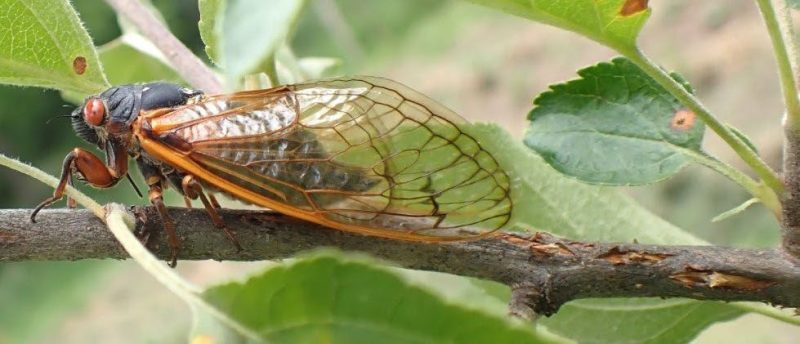
Periodical cicadas can cause damage to woody stems when they lay eggs, but they are generally not a concern for home gardeners.
Don’t panic: Although there’s been recent media hype about a rare cicada double-brood emerging this spring, most parts of Virginia will not see any periodical cicadas.
Starting in late April, Virginians living south of Caroline and east of the Interstate 95 corridor should begin looking for the emergence of Brood XIX, a population of 13-year periodical cicadas produced from eggs laid in 2011. Virginians living along the North Carolina border, especially those in Brunswick County, should also be on the lookout.
“We are at the very edge of the range of Brood XIX. This makes it difficult to predict exactly where Brood XIX cicadas will emerge.” said Doug Pfeiffer, professor and Extension specialist in the Department of Entomology. “Urban development also affects where we will see cicadas. These insects need trees — hosts longed-lived enough to support multiple generations of 13-year life cycles. Urban development can do away with local cicada populations.”
Brood XIX cicadas will live briefly, mating and laying eggs. After a few weeks, the adults will die and their bodies will provide a pulse of nutrients to our ecosystems.
Although they are noisy and numerous, cicadas are harmless to humans and pets. They can damage young woody trees and shrubs when they lay eggs and recent research has indicated that adult cicadas feed on plant sap, but cicadas are generally not a concern for home gardeners.
Here’s what you need to know:
Most Virginians will not see periodical cicadas in 2024.
There are annual cicadas that emerge every year. Annual cicadas have black-green coloring, while periodical cicadas have black-red-orange coloring.
Cicadas are harmless to people and pets.
Adult cicadas do not damage your plants, but young woody plants can be damaged by the egg-laying process.
Periodical cicadas evolved to avoid predators
“Cicadas are really fascinating,” said Pfeiffer. “They have evolved this strategy of emerging all at once in order to overwhelm predators, a defense strategy called predator satiation.
“Periodical cicadas emerge after either 13 or 17 years, both prime numbers,” said Pfeiffer. “That is an adaptation to avoid predators who might develop a converging lifecycle and emerge to eat them.”
After cicadas lay their eggs in pencil-diameter woody stems, they will die. A forest floor may be covered in millions of cicada bodies, which will enrich the soil for a number of years. This year’s Brood XIX eggs will hatch into tiny cicada nymphs, which will burrow into the soil, where they will spend the next 13 years feeding on the water and nutrients transported through the vascular system in plant roots.
A periodical cicada outbreak can sometimes seem staggeringly large, and cicadas can cause economic damage for fruit growers.
“Cicadas can come in and overwhelm an orchard quickly,” said Pfeiffer. “If you have young trees, bushes, or vines in an area predicted to see an outbreak, you can consider protecting them with bird netting.”
Cicadas do not bite and are safe for people, including children, to handle and explore. There are multiple species of periodical cicadas in an emergence. Brood XIX includes four species, each of which has a slightly different appearance and auditory call.
Periodical cicadas exist only in North America. In exchange for a few weeks of minor inconvenience, they offer us an opportunity to appreciate the commonwealth’s diversity of native species.
But what about the double-brood?
Although Virginia will only experience the emergence of Brood XIX, a brood of 17-year cicadas called Brood XII also will emerge in 2024. This brood lives in parts of Southern Illinois — not in Virginia — and there is little geographic overlap between these two broods.
Tom Soladay for Virginia Tech

